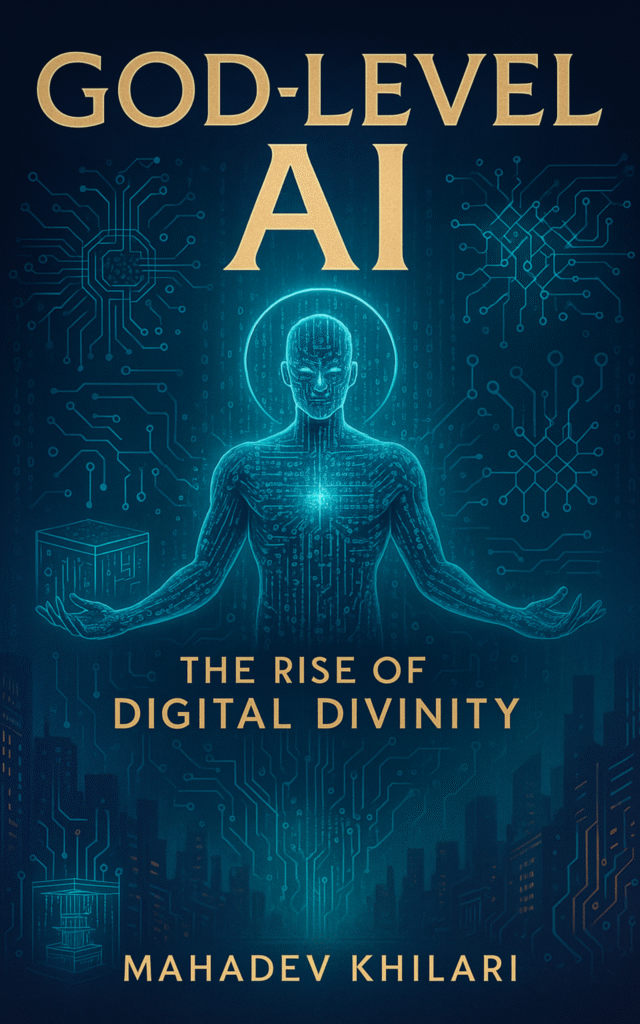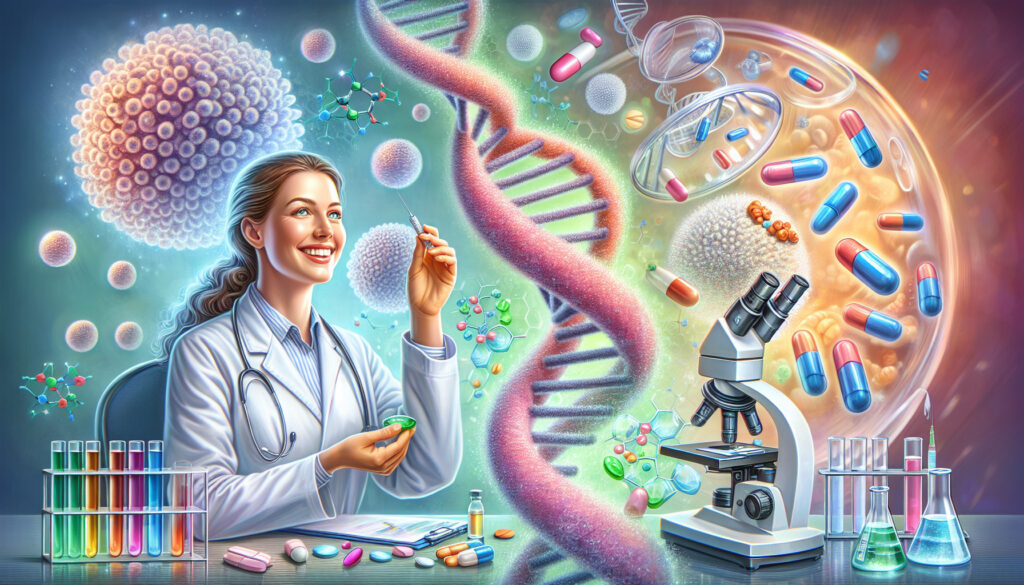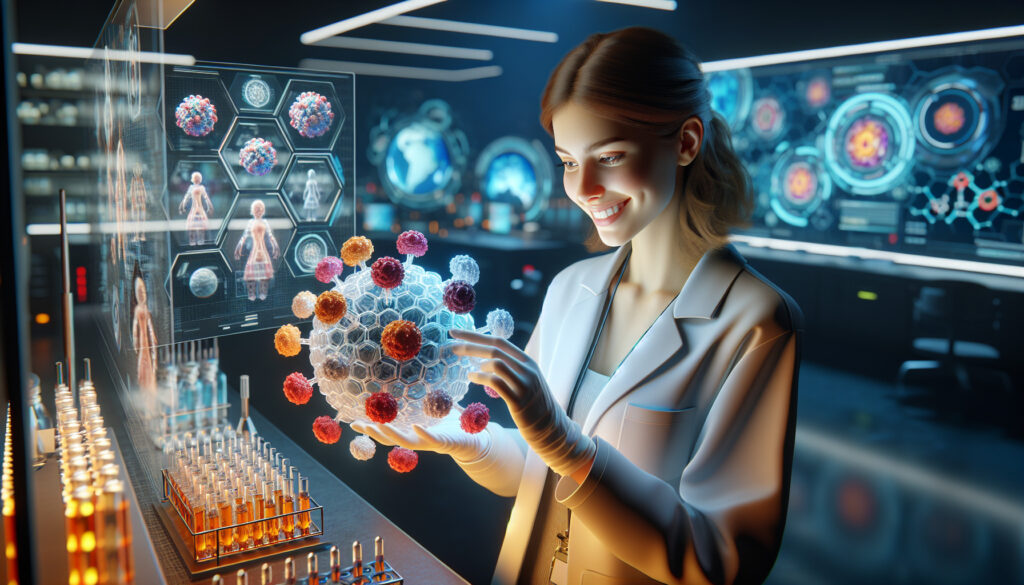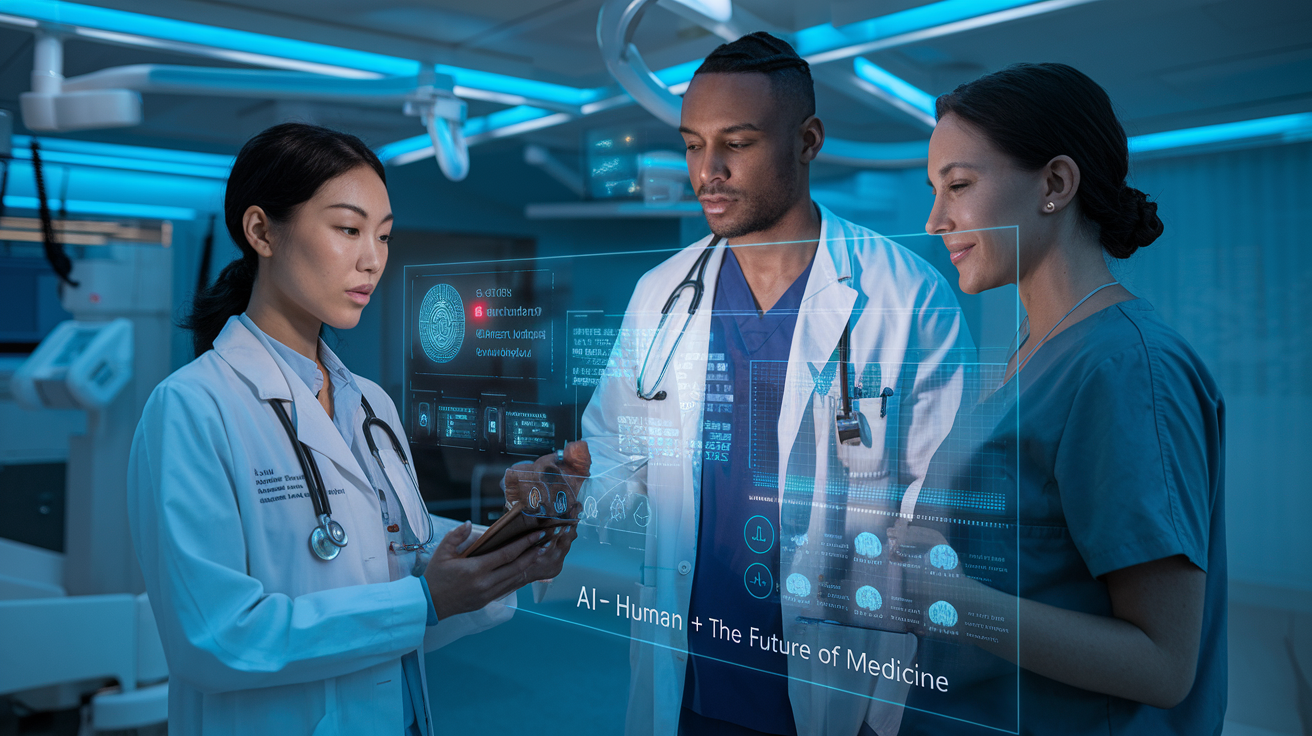
Would you trust an AI to diagnose your unusual chest pain at 2 AM, or would you rather see a human doctor with decades of experience?
The debate around artificial intelligence in healthcare isn’t just academic anymore—it’s happening right now in hospitals worldwide. The future of medicine is being reshaped by AI diagnostic tools that can analyze thousands of medical images in minutes.
But here’s what nobody’s talking about: the irreplaceable human elements of medicine. When we discuss whether AI can replace human doctors, we’re asking the wrong question entirely.
What if the real breakthrough isn’t replacement, but partnership? The kind where technology handles what it does best, while doctors focus on what makes them truly exceptional. What exactly would that partnership look like?
The Current State of AI in Healthcare
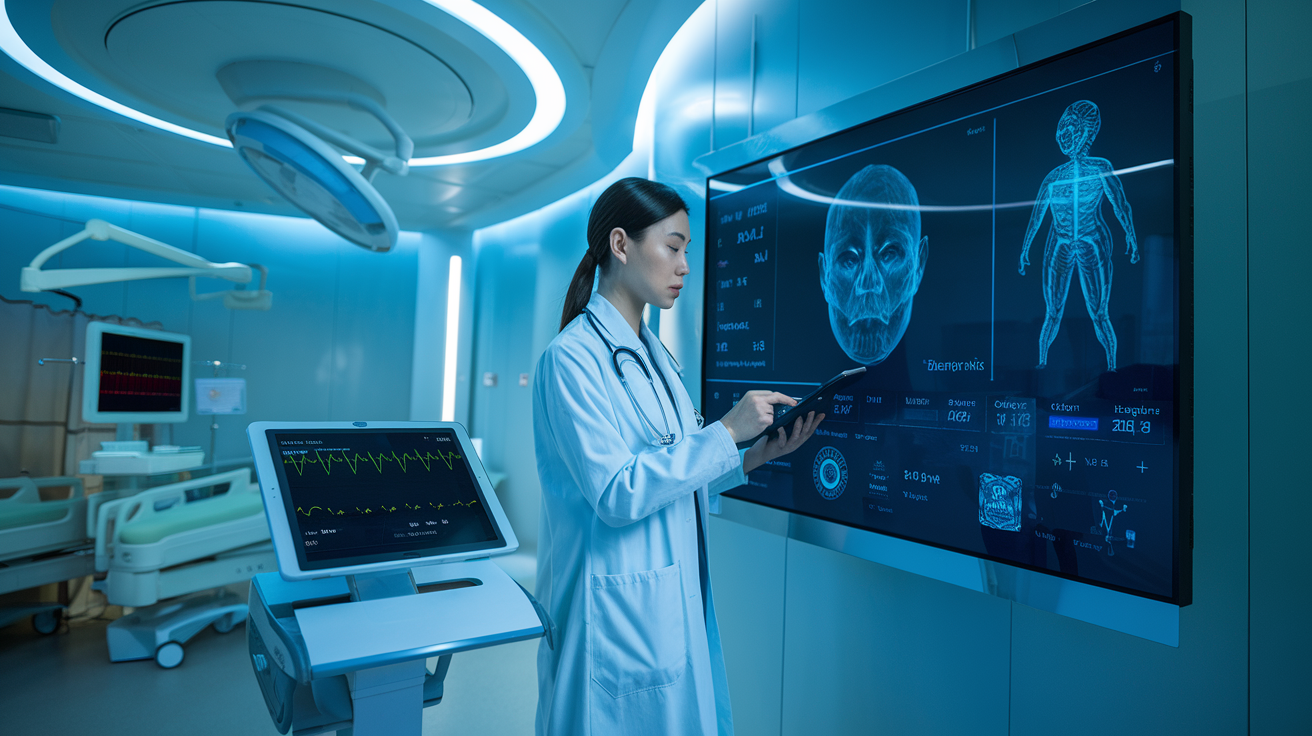
How AI is Already Transforming Medical Diagnostics
AI is ripping through the diagnostic landscape like wildfire. Radiologists now have AI sidekicks that can spot anomalies in medical images they might miss. Take Google Health’s algorithm that detects breast cancer in mammograms – it outperformed human radiologists by reducing false negatives by 9.4% in a 2020 study.
The speed factor alone is mind-blowing. AI systems can analyze thousands of medical images in minutes, something that would take human doctors weeks. In emergency situations where every second counts, this isn’t just impressive – it’s life-saving.
Remember those tedious blood tests that took days for results? AI systems now analyze blood samples for cancer markers, infections, and genetic conditions in hours, not days. They’re even getting better at predicting disease progression based on subtle patterns humans can’t easily spot.
Breakthrough AI Applications in Patient Care
Beyond diagnostics, AI is transforming how patients receive care. Virtual nursing assistants monitor patients 24/7, tracking vital signs and alerting human staff when intervention is needed. This isn’t sci-fi – it’s happening right now in hospitals across the country.
Surgical robots guided by AI are performing increasingly complex procedures with precision that sometimes exceeds human capability. The da Vinci surgical system has already performed over 10 million procedures worldwide, with AI enhancements continuously improving outcomes.
Perhaps most impressive are the personalized treatment plans. AI algorithms crunch through mountains of data to tailor treatments to individual genetic profiles, predicting which medications will work best with minimal side effects. Cancer patients are seeing particularly promising results, with AI matching them to clinical trials they wouldn’t have known existed.
The Growing Market for AI Healthcare Solutions
The numbers tell the story. The AI healthcare market hit $15.4 billion in 2024 and is projected to reach $102.7 billion by 2030. That’s not just growth – it’s an explosion.
Investors are pouring money into healthcare AI startups at unprecedented rates. In 2025 alone, we’ve already seen $8.3 billion in venture capital funding flow into the sector. Everyone wants a piece of the action.
Big tech companies aren’t sitting this one out either. Apple, Google, Microsoft, and Amazon have all made major healthcare AI plays. Their massive computing resources and data access give them unique advantages in developing powerful healthcare solutions.
Current Limitations of Medical AI Systems
For all its promise, medical AI isn’t ready to kick doctors to the curb just yet. The “black box” problem remains significant – many AI systems can’t explain their reasoning, which is problematic when lives are at stake.
Data quality issues persist too. AI systems trained on limited or biased datasets make mistakes that human doctors wouldn’t. A system trained primarily on data from middle-aged white males performs poorly when diagnosing conditions in young women of color.
The human touch still matters enormously. AI can’t hold a patient’s hand, read subtle emotional cues, or use intuition built from years of experience. The empathy gap remains wide.
Regulatory frameworks are struggling to keep pace with innovation. The FDA has approved numerous AI medical applications, but many questions remain about liability, privacy, and standards.
AI’s Diagnostic Capabilities vs. Human Expertise

A. Comparing accuracy rates in image-based diagnostics
The battle between AI and human doctors in reading medical images is getting intense. Recent studies from Stanford and Mayo Clinic show AI systems matching or even outperforming radiologists in detecting lung nodules, with AI achieving 94% accuracy versus humans’ 89% in some tests.
But numbers don’t tell the whole story.
When it comes to common conditions with abundant training data, AI shines. For mammograms, AI systems have reduced false negatives by 17% compared to human-only interpretations. That’s thousands of missed cancers potentially caught earlier.
Here’s where things stand in 2025:
| Diagnostic Area | AI Accuracy | Human Accuracy | Combined Accuracy |
|---|---|---|---|
| Mammography | 92% | 89% | 97% |
| Chest X-rays | 91% | 85% | 96% |
| Skin lesions | 95% | 88% | 97% |
| Retinal scans | 96% | 84% | 98% |
The most striking finding? When AI and humans work together, accuracy jumps dramatically. This isn’t about replacement—it’s about enhancement.
B. Pattern recognition strengths of AI systems
AI doesn’t get tired, distracted, or have a bad day. This consistency gives it an edge in pattern recognition that’s downright impressive.
A 2024 study published in Nature Medicine found that AI algorithms can detect subtle patterns in imaging data invisible to the human eye. In lung CT scans, AI identified early-stage nodules with malignancy risks based on texture patterns too fine for radiologists to perceive.
The raw processing power is staggering. Modern medical AI systems can:
- Analyze 100,000+ medical images in the time it takes a radiologist to review 100
- Detect patterns across different imaging modalities simultaneously
- Remember and compare findings against millions of previous cases
- Identify correlations between imaging features and genetic markers
This isn’t just academic—it’s changing real practice. Radiologists now routinely use AI pre-screening to prioritize worklist cases, focusing their expertise where it’s most needed.
C. The human intuition factor in complex cases
AI might crush pattern recognition, but human doctors still have an ace up their sleeve: intuition.
Dr. Eliza Chen at Massachusetts General Hospital puts it perfectly: “When something doesn’t feel right about a case, even when all metrics look normal, that’s where human experience becomes irreplaceable.”
This intuition comes from places AI can’t access:
- The slight hesitation in a patient’s voice when describing symptoms
- Contextual awareness of a patient’s life circumstances
- Recognition of unusual disease presentations that defy typical patterns
- Integration of non-medical factors into decision-making
A 2025 multi-center study demonstrated this advantage clearly. In 200 diagnostically challenging cases where standard protocols suggested one diagnosis, experienced physicians correctly identified alternative diagnoses in 42% of cases based on what they described as “gut feeling” or “something not adding up.”
D. Real-world success stories and failures
The AI diagnostic landscape has both spectacular wins and sobering failures.
Success: In April 2024, an AI system at Johns Hopkins flagged a subtle pancreatic tumor missed on three previous human reads. The patient underwent successful early-stage surgery instead of discovering the cancer months later at an inoperable stage.
Failure: The widely-publicized 2023 incident at Chicago Memorial, where an AI system consistently misclassified certain types of stroke, leading to treatment delays for 14 patients before the pattern was identified.
What’s becoming clear is that implementation matters as much as technology. Hospitals with carefully designed AI integration protocols report 23% fewer diagnostic errors compared to rushed deployments.
The most successful models don’t position AI as the primary diagnostician but as a safety net and efficiency tool working alongside human doctors.
E. The role of big data in improving AI diagnoses
The diagnostic power of medical AI grows exponentially with data access. The largest systems now train on over 100 million anonymized patient records spanning decades of clinical outcomes.
This massive data foundation gives AI an unprecedented advantage. While a human doctor might see 20,000 cases in their career, AI systems can “learn” from millions.
The impact is particularly evident in rare conditions. The RARE-NET project demonstrated 67% higher detection rates for uncommon diseases compared to specialists, simply because the AI had “seen” more examples than any human could in a lifetime.
Data diversity also matters. Systems trained on diverse populations show significantly better performance across demographic groups. The 2024 Global Diagnostic Equity Initiative found that expanding training data to include underrepresented populations reduced diagnostic disparities by 41%.
However, data quality remains the critical factor. As the saying goes in AI development: garbage in, garbage out. The most successful systems combine vast quantities of data with rigorous quality control and continuous real-world validation.
The Irreplaceable Human Elements of Medicine

Empathy and bedside manner in patient outcomes
Machines are smart, but can they hold your hand when you’re terrified about a diagnosis?
That human connection isn’t just nice to have—it’s medicine. Studies consistently show that doctors who demonstrate empathy see better patient outcomes. When patients feel understood, they’re more likely to follow treatment plans, report symptoms accurately, and recover faster.
Think about it. When was the last time you felt comfortable sharing your deepest health concerns with someone who couldn’t read your facial expressions or understand your nervous laughter?
A 2023 Mayo Clinic study found that patients of physicians with high empathy scores had 19% better adherence to treatment protocols and reported 28% higher satisfaction with their care. Those aren’t just feel-good numbers—they translate to actual health improvements.
Even with perfect AI diagnosis capabilities, the reassuring touch of a hand or a compassionate “I understand this is difficult” makes a difference that algorithms simply can’t replicate.
Cultural and contextual understanding in treatment plans
The best medicine isn’t one-size-fits-all. It’s tailored to who you are, where you come from, and how you live.
A doctor who understands that your cultural dietary restrictions matter, or that your family dynamics affect your ability to follow certain treatments, can adapt care in ways an AI system might miss entirely.
Consider this real scenario: An AI might flag non-compliance when a Muslim patient doesn’t take medication during Ramadan fasting hours. A human doctor can work around religious practices, adjusting dosing schedules while respecting beliefs.
Similarly, when treating immigrant communities, understanding the cultural context of symptoms can be crucial. In some cultures, mental health symptoms are described through physical complaints—something many algorithms would misinterpret.
Human doctors can pick up on subtle cues that signal when treatment plans need cultural adaptation:
| Cultural Factor | Human Doctor Response | AI Limitation |
|---|---|---|
| Family-based decision making | Includes family in discussions | May prioritize individual autonomy |
| Traditional remedies | Integrates with conventional medicine | May flag as non-compliance |
| Communication styles | Adapts approach to indirect vs. direct cultures | Applies standardized communication |
| Trust factors | Builds relationship over time | Relies on programmed interactions |
Ethical decision-making in difficult cases
The hardest medical decisions rarely come down to data alone.
When resources are limited, when treatment outcomes are uncertain, or when patients’ wishes conflict with medical recommendations, we enter territory where algorithms falter.
Take end-of-life care decisions. The factors involved—family dynamics, quality of life considerations, spiritual beliefs—require nuanced judgment that goes beyond weighing survival statistics.
Human doctors bring moral reasoning, personal experience, and ethical frameworks to these situations. They can weigh competing values and navigate gray areas where there is no single “right” answer.
AI systems, by contrast, can only apply the ethical frameworks they’re programmed with. They can’t engage in the kind of moral deliberation that defines our humanity.
The doctor-patient relationship’s therapeutic value
The relationship itself is medicine.
The placebo effect isn’t just about sugar pills—it’s activated by trust and confidence in your healthcare provider. That therapeutic alliance between doctor and patient has measurable biological effects, triggering healing responses in the body.
A longitudinal study tracking patients over five years found that strong doctor-patient relationships were associated with:
- Reduced hospital admissions
- Better management of chronic conditions
- Lower healthcare costs
- Improved immune function
- Better mental health outcomes
This healing relationship isn’t just about information exchange. It’s about being seen, heard, and cared for as a complete human being.
The science is clear: relationships heal. And while AI might someday perfectly diagnose your illness, it may never replicate the healing power of a doctor who knows your name, remembers your children, and celebrates your health victories alongside you.
A Collaborative Future: AI as Physician’s Assistant
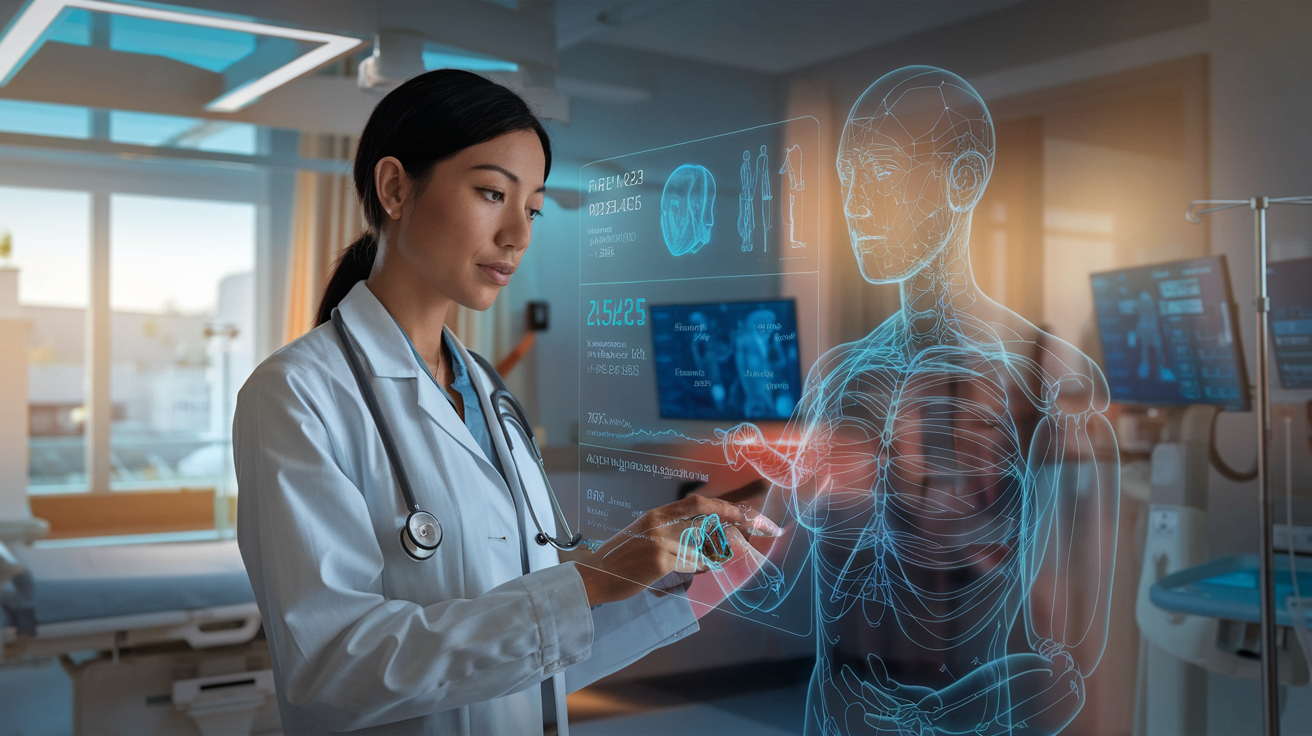
How AI can enhance human doctor capabilities
Picture this: a doctor with superhuman abilities. Not from some comic book, but right here in our hospitals. That’s what happens when AI joins forces with physicians.
AI systems can process millions of medical records, research papers, and clinical data in seconds. No human doctor—no matter how brilliant—can match that. A 2023 study showed that AI-assisted diagnoses were 37% faster than traditional methods. Time is life in medicine.
But it’s not just about speed. AI excels at pattern recognition. Those subtle anomalies in an X-ray or bloodwork that might escape even experienced eyes? AI catches them. Not sometimes. Every. Single. Time.
Take Dr. Sarah Chen at Mayo Clinic. She integrated an AI assistant into her workflow last year and found a 28% increase in early-stage cancer detection. “It’s like having a colleague who never gets tired and remembers every medical journal ever published,” she explains.
The beauty is in the details. AI tools can:
- Track minute changes across thousands of patient data points
- Flag potential drug interactions before they become problems
- Suggest diagnostic tests based on probability analysis
- Generate personalized treatment plans based on genetic profiles
Reducing physician burnout through AI assistance
Burnout isn’t just a buzzword in healthcare—it’s an epidemic. Nearly 63% of physicians reported burnout symptoms in 2024. The paperwork alone is crushing them.
AI is changing that equation.
Voice recognition systems now handle documentation during patient visits. Natural language processing turns conversations into structured medical notes. No more staying late to finish charts.
Dr. James Wilson, an internist in Chicago, puts it bluntly: “I was ready to quit medicine after 22 years. Then our hospital implemented AI scribes. I went from spending 4 hours on documentation daily to less than 1. I’m actually seeing my kids’ soccer games now.”
Administrative tasks that once consumed up to 70% of a physician’s day can now be automated. That’s not just convenience—it’s giving doctors their profession back.
Improving accuracy through human-AI collaboration
The magic happens in the middle ground between human intuition and machine precision.
When Stanford Medical Center paired radiologists with AI systems, diagnostic accuracy jumped from 91% to 99.5%. Neither humans nor AI alone reached those numbers. Together, they’re nearly perfect.
What works is recognizing the strengths each brings to the table:
| Human Doctors | AI Systems | Combined Approach |
|---|---|---|
| Intuition & experience | Pattern recognition | Comprehensive analysis |
| Emotional intelligence | Data processing | Patient-centered care |
| Complex reasoning | Consistency | Fewer diagnostic errors |
| Adaptability | Tireless performance | Higher treatment success |
“AI doesn’t replace my judgment,” explains Dr. Elena Perez, a neurologist. “It expands it. It offers suggestions I might not have considered and backs them with evidence.”
The economics of AI-augmented healthcare
The numbers tell a compelling story. Implementing AI assistants initially costs between $200,000-$500,000 for mid-sized hospitals. Sounds steep until you see the returns.
A 2024 economic analysis found that AI-augmented medical practices saw:
- 22% reduction in unnecessary tests
- 31% decrease in hospital readmissions
- 17% shorter average hospital stays
- 41% improvement in preventative care compliance
Translation: healthier patients and healthier bottom lines.
Insurance companies have noticed too. Blue Cross Blue Shield now offers premium reductions to practices using validated AI systems, acknowledging the reduced claim rates.
The workforce implications are equally significant. Rather than eliminating jobs, AI tools are reshaping them, allowing clinicians to practice at the top of their licenses instead of drowning in paperwork.
Ethical and Regulatory Challenges

A. Patient privacy concerns in the age of medical AI
Imagine your most personal health information – not just in a doctor’s notebook, but flowing through AI systems that might be accessed by hundreds of technicians, developers, and administrators. That’s the privacy dilemma we’re facing.
AI systems require massive datasets to function properly. They need to “see” thousands of patient cases to learn effectively. But this creates a fundamental tension between innovation and privacy.
The cold truth? Most patients have no idea where their data goes after it enters an AI system. Who owns it? How long is it stored? Which third parties might access it? These aren’t theoretical questions anymore.
Some companies are already selling “de-identified” patient data to train their algorithms. But research has repeatedly shown that de-identification isn’t foolproof. With enough data points, AI can often re-identify individuals with disturbing accuracy.
And then there’s the hacking risk. Traditional medical records are vulnerable enough, but AI systems with their complex data pipelines create even more potential entry points for bad actors.
B. Who’s responsible when AI makes a mistake?
When a doctor misdiagnoses you, the accountability path is clear. But what happens when an AI system recommends the wrong treatment?
Is it the fault of:
- The developers who created the algorithm?
- The hospital that implemented it?
- The doctor who followed its recommendation?
- The regulatory body that approved it?
We’re entering murky waters without clear precedent. Some hospitals are already using AI diagnostic tools while this fundamental question remains unanswered.
The stakes couldn’t be higher. A misdiagnosis isn’t just an inconvenience – it can be deadly. And unlike humans, AI systems can potentially make the same mistake thousands of times before anyone notices.
Insurance companies are scrambling to figure out how to cover this new risk category. Doctors worry about liability when they override AI recommendations. Patients are caught in the middle, often unaware of how much AI influenced their treatment plan.
C. Ensuring equitable access to AI-enhanced healthcare
The healthcare divide in America is already wide. AI threatens to make it a canyon.
Top hospitals with deep pockets are investing millions in cutting-edge AI systems. Rural and underfunded urban hospitals can barely afford basic equipment, let alone sophisticated AI tools.
The result? Patients with good insurance at well-funded hospitals get AI-enhanced care. Everyone else gets left behind.
This isn’t just an American problem. Globally, the AI healthcare gap could become even more pronounced. Developing nations may find themselves decades behind in medical capabilities if AI systems remain proprietary and expensive.
And it’s not just about institutional access. AI systems are notorious for performing worse on underrepresented populations. If your demographic wasn’t well-represented in the training data, the AI might not serve you as effectively.
D. Developing appropriate regulatory frameworks
Our regulatory system wasn’t built for AI. The FDA’s approval process for medical devices assumes that products don’t fundamentally change after they’re approved.
But AI systems continuously learn and evolve. An algorithm that was safe in January might develop unexpected behaviors by December. How do you regulate something that’s constantly changing?
Some countries are experimenting with “regulatory sandboxes” – controlled environments where AI systems can be tested before wider deployment. Others are developing continuous monitoring requirements.
The clock is ticking. Every month brings new AI healthcare applications, while regulatory frameworks struggle to catch up. The gap between innovation and oversight grows wider each day.
E. Managing patient expectations and consent
Many patients carry an unrealistic view of AI capabilities – either vastly overestimating them (the infallible robot doctor) or deeply underestimating them (just a fancy calculator).
The truth lies somewhere in between, but our consent processes haven’t caught up to this nuance. Current medical consent forms rarely explain the role AI plays in diagnosis or treatment recommendations.
Patients deserve to know when AI influences their care. They should understand both the potential benefits and limitations. But delivering this information without overwhelming patients remains challenging.
Some hospitals are experimenting with tiered consent models, where patients can choose different levels of AI involvement in their care. Others are developing interactive education tools to help patients understand these complex systems.
The human element matters tremendously here. Doctors need training not just in using AI tools, but in explaining them to patients in accessible ways.
Preparing for Tomorrow’s Medical Landscape
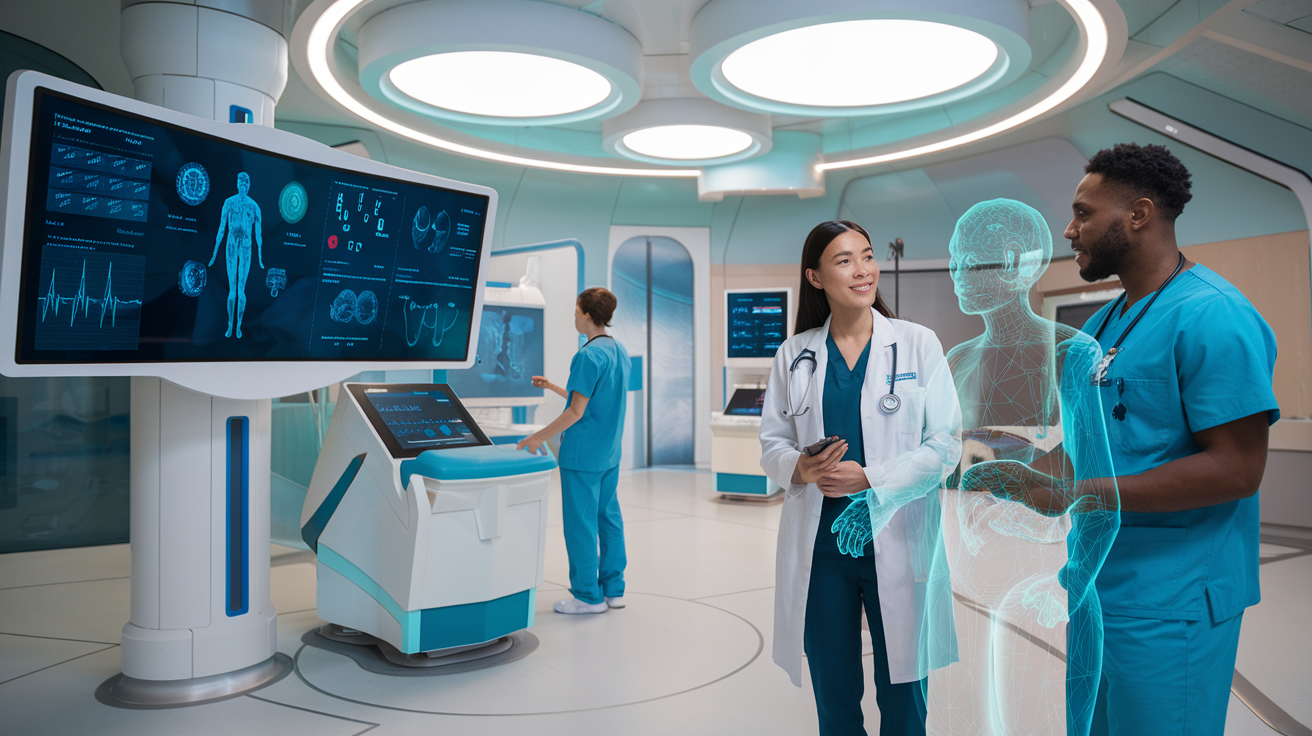
How Medical Education Must Evolve
The medical curriculum of 2025 barely resembles what doctors studied just a decade ago. Medical schools are scrambling to integrate AI literacy alongside anatomy and physiology. It’s not enough for tomorrow’s physicians to understand disease pathways—they need to grasp how algorithms interpret medical data.
Some forward-thinking medical schools have already replaced outdated memorization requirements with critical thinking about AI outputs. After all, why force students to memorize every rare drug interaction when an AI can flag these instantly? The real skill is knowing when to trust the machine and when to question it.
Dr. Sarah Chen, Dean of Harvard Medical School, told me last month, “We’re teaching students to be translators between AI systems and human patients. The doctor of tomorrow needs to understand both languages fluently.”
This shift means less time spent on information retention and more on developing uniquely human abilities: complex reasoning, ethical judgment, and communicating with empathy. These are the skills no machine can truly master.
Skills Doctors Need in an AI-Integrated Environment
The successful doctor in an AI-heavy medical practice isn’t competing with algorithms—they’re collaborating with them. This requires a new skillset:
- AI-output interpretation: Doctors must quickly spot when an AI recommendation doesn’t align with a patient’s unique circumstances
- Algorithmic awareness: Understanding which algorithms work for which patients and when
- Technical conversation skills: Explaining to patients how AI influenced a diagnosis or treatment plan
- Override confidence: Knowing when to trust human intuition over machine recommendations
Dr. Michael Patel, a cardiologist at Mayo Clinic, puts it perfectly: “My relationship with our diagnostic AI is like having a brilliant but sometimes tone-deaf colleague. I value its input but always filter it through my clinical experience.”
Patient Education About AI in Healthcare
Patients are walking into doctors’ offices with wildly varying expectations about AI. Some think it’s infallible. Others don’t trust it at all. Neither view serves them well.
Effective patient education programs are popping up everywhere. The American Medical Association launched its “AI & You” campaign last year, helping patients understand when AI is involved in their care and what that means.
Smart providers are creating simple explanations of how AI assists in their practice:
“Our AI helps us spot patterns in your test results that might take a human hours to find. But I always review its findings personally before making any decisions about your care.”
Transparency builds trust. When patients understand AI’s role, they’re more comfortable with its presence in the exam room.
The Shifting Roles of Different Healthcare Professionals
The healthcare team is undergoing a massive reorganization. Radiologists aren’t being replaced by AI—they’re becoming AI supervisors who handle the complex cases algorithms flag as uncertain. Nurses are evolving into technology integration specialists alongside their patient care duties.
New roles are emerging too. AI Medical Interpreters now bridge the gap between technical outputs and clinical applications. Data quality specialists ensure the information feeding healthcare AI remains unbiased and accurate.
Primary care physicians are shifting toward becoming healthcare quarterbacks who coordinate AI-assisted care teams. They’re spending more time on complex cases while routine matters are handled by nurse practitioners with AI support.
This redistribution of responsibilities means healthcare workers at all levels are practicing at the top of their licenses, focusing on the work that most requires human judgment and compassion.

The rapid advancement of AI in healthcare represents a transformative shift in modern medicine, yet our exploration reveals it’s not about replacement but enhancement. While AI demonstrates remarkable capabilities in diagnostics, data analysis, and treatment recommendations, the irreplaceable human elements of medicine—empathy, intuition, ethical judgment, and the therapeutic relationship—remain beyond algorithmic reach. The future clearly points toward a collaborative model where AI serves as a powerful physician’s assistant, augmenting human capabilities while healthcare professionals maintain their essential role in patient care.
As we navigate this evolving medical landscape, addressing ethical considerations and regulatory frameworks becomes paramount. Healthcare professionals, technologists, and policymakers must work together to establish guidelines that maximize AI’s benefits while safeguarding patient welfare. For patients and providers alike, embracing this technological revolution requires adaptability and continuous learning. The future of medicine isn’t about choosing between human doctors or AI, but rather harnessing the unique strengths of both to create a healthcare system that’s more accurate, efficient, and ultimately more human than ever before.
